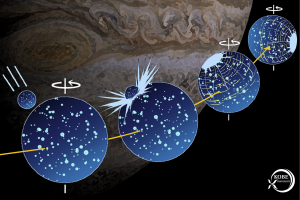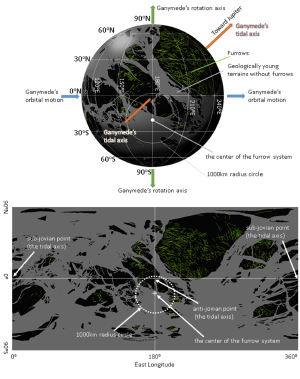Blog
Wham!
6 September 2024
 HIRATA Naoyuki (CC BY)
HIRATA Naoyuki (CC BY)There’s a lot going on in the early period of a planetary system. Planets can shift as gravitational resonances cause them to migrate. Comets, asteroids, and even entire planets can be cast out of their system, and of course sometimes large bodies collide.
The largest known planetary collision in our solar system was the early impact of Earth with a Mars-sized body, which produced our modern Earth-Moon. It was once thought that an even larger body collided with Uranus in its youth, giving the pale blue world its odd axial tilt, but the fact that Uranus’ old moons have tilted orbits as well suggests a series of impacts rather than one big one.
Finding evidence for large impacts can be a challenge, because unlike smaller impacts that produce telltale craters, large impacts can so dramatically change the terrain of a world that the impact is largely erased. But the evidence can be seen sometimes if you look closely, as a recent study of Ganymede shows.1
 HIRATA Naoyuki (CC BY)
HIRATA Naoyuki (CC BY)Ganymede is the largest moon of Jupiter and the largest moon in the solar system. It is larger than the dwarf planets such as Ceres and Pluto, and even larger than Mercury. Its proximity to Jupiter has kept it geologically active, which means the world has a range of surface features. There are dark regions peppered with craters, and lighter regions that are younger. But perhaps the most distinctive features of Ganymede’s surface are a series of concentric furrows that center around Ganymede’s tidal axis. Since Ganymede is tidally locked with Jupiter. This means one side always faces Jupiter, just as our Moon always shows the same side to us. The center of the furrows is located at the exact far point from Jupiter, which made their origin a bit of a mystery.
The most common way to create concentric furrows is by a large impact. Big collisions rattle a world so strongly that ridges and furrows can form around it. But it’s extremely unlikely that an impact would happen exactly at the tidal axis, so another idea was that the furrows are due to tidal forces. As Ganymede cooled it would shrink slightly causing fissures to form. Perhaps the way in which Ganymede cooled caused them to form concentrically.
It was this mystery that drew Naoyuki Hirata to study the furrows. Through studies of other large impact sites, he realized that a large impact can shift the orientation of a tidally locked world. If the impact is large enough it can shift the impact site to the tidal axis, just as we see on Ganymede. So Hirata ran computer simulations to estimate the size and original location of the collision. He found that the most likely scenario is that an asteroid about 300 kilometers across struck Ganymede in its northern hemisphere about 4 billion years ago.
Although it’s a great result, it can’t entirely rule out the thermal cooling model. To do that we’ll need to gather more evidence. Fortunately, the ESA’s Jupiter Icy Moons Explorer (JUICE) mission is on its way to the giant planet, and is expected to start orbiting Ganymede in 2034. So we only have to wait a decade or so before this mystery is fully solved.
Hirata, Naoyuki. “Giant impact on early Ganymede and its subsequent reorientation.” Scientific Reports 14.1 (2024): 19982. ↩︎